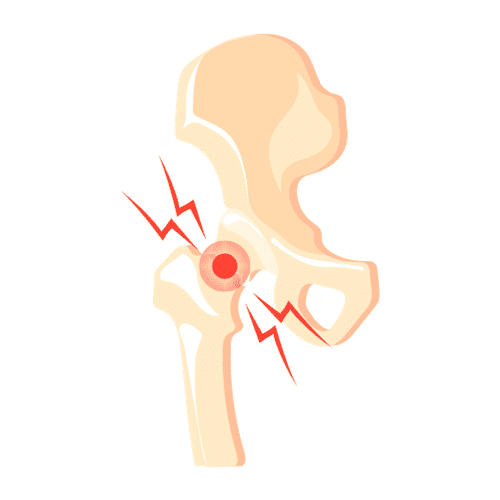Hip Dysplasia is a condition that can affect dogs of all shapes, sizes, and backgrounds. From the tiniest Chihuahua to the grandest Great Dane, no breed is immune to the possibility of hip dysplasia. Some dogs’ symptoms will go undetected for many years, while others start showing obvious signs of hip dysplasia from a very young age.
Fortunately, there are treatments and rehabilitation options available that can help alleviate discomfort and improve their quality of life, allowing these furry friends to enjoy a happier, more active existence.
Hip dysplasia, often referred to as HD, is a common orthopaedic condition in dogs where the hip joint doesn’t develop properly. It’s a bit like trying to fit two puzzle pieces that don’t quite match, causing friction and wear in the joint. This misalignment can lead to pain, early-onset arthritis and reduced mobility as the dog ages.
Dogs with hip dysplasia may experience varying degrees of pain, difficulty moving, and a reluctance to engage in physical activities.

Hip dysplasia can often go undetected in its early stages, but early diagnosis and intervention can significantly improve a dog's prognosis. Regular veterinary check-ups, especially for breeds prone to HD, can help catch the condition before it worsens.
Some dogs will be prone to hip dysplasia due to their genes & anatomical features. Any dog can get it, but some of the more susceptible breeds include German Shepherds, Labradors, Rottweilers, Great Danes, Pugs and various Bulldog breeds.
The symptoms can also come on at any age, but there is a correlation between the age of onset and the severity of the disease. Generally, the dogs that show early signs of HD tend to be more severe presentations.
Symptoms of Canine Hip Dysplasia may include some or all of the following:

Reluctance to Move
Compensation
Muscle Wastage
Gait Abnormalities
Pain/Discomfort
Initially your vet will suspect hip dysplasia through a combination of the symptoms you report, and their physical examination. The diagnosis of Hip Dysplasia is confirmed through an x-ray. The x-ray will show if there’s an incongruence of the ball and socket joint in the hip, if there’s a reduction in joint space and signs of early onset osteoarthritis.
A specific type of X-ray, called the PennHIP is considered the gold standard way of diagnosing HD, although not all veterinary practices offer this type of exam. Unlike standard X-rays, this technique evaluates joint laxity, a factor that can’t be assessed through conventional X-ray imaging. The PennHIP method involves capturing images of the hip joint from three distinct positions and applying a score to the hip, which allows them to have a more accurate prediction of the likelihood of osteoarthritis later on in life.
There’s a range of treatment options available to dogs suffering Hip Dysplasia. For young dogs and dogs with debilitating pain, surgery will most likely be recommended.
For dogs with less severe HD, or dogs where it’s presented later on in life, a multifactorial conservative approach can be very successful.
The kind of surgical approach will firstly depend on the age of your dog, as there are two very successful options that only exist for puppies.
The other surgical approaches depend on your personal preference and budget.
Conservative veterinary treatment consists of everything else that isn’t surgery. Each case is patient-specific, but may include some of the following:
Rehabilitation is a vital yet frequently underestimated aspect of the recovery journey. A common belief in the veterinary world is that if a surgical procedure goes well, rehabilitation may not be necessary. But imagine undergoing a significant hip surgery, and your surgeon advises you to skip physiotherapy and exercise entirely, recommending only bed rest for 6-8 weeks before resuming normal activities.
You might have some concerns with that approach, and even seek a second opinion as the the next step. In the field of human orthopaedics, bed rest has long been abandoned as a recovery strategy, with most orthopaedic procedures emphasising immediate rehabilitation.
At the Animal Rehab Klinik, our mission is to advocate for a similar understanding of the critical role of rehabilitation in the veterinary world and encourage its recommendation for all patients.
The rehabilitation process varies depending on the severity of the hip dysplasia, if they’ve had surgery, the kind of surgery they’ve had, if there are any complications following surgery and the owner’s goals.
In the younger dogs who’ve had early intervention with a JPS or TPO, it’s unlikely that we need to do a lot of rehabilitation, if any, unless there are complications after surgery.
We’ll go a bit slower & more carefully at the start because of the amount of healing that needs to take place. Long term shouldn’t be much need for continued rehab if everything has gone as well as it can.
We can go more aggressively at the start than the THR and get a quicker initial recovery. The overall improvement won’t be as good as a THR that has gone perfectly. May need some ongoing maintenance rehab to help manage the asymmetry in the hind end as the dog is missing it’s normal hip joint.
The nature of how aggressively we treat depends on how the dog is responding and what we expect. An old dog will have a limited scope for improvement, so we will usually approach a little slower, and so too a dog whose hip is really sensitive and prone to flaring up by doing too much too soon. A younger dog or dog with milder HD may cope with a more aggressive style of treatment which can bring quicker results. In either case – conservative management usually required ongoing ‘maintenance’ treatment to keep on top of the HD. Every dog has different requirements which we work out as they go along, but typically this will range from monthly to weekly ongoing treatments.
For most of our hip dysplasia patients we’ll approach hip dysplasia rehab in a similar two-pronged way – addressing the pain and improving stability.
It’s important to do both of these because if you don’t take care of the pain and discomfort, a dog won’t want to use their leg which limits the hip’s ability to get strong and stable, which in turn, then makes the hip less painful.
This is a great way to promote healing to an injured area and to reduce pain in a non-invasive way. Just like plants get energy from the sun, the damaged cells in our body also absorb energy from the laser which promote quicker healing. Laser is great both for post-op when you’re trying to speed up the initial recovery after surgery, or in the chronic cases where you’re aiming to reduce pain and inflammation.
For dogs dealing with hip dysplasia, massage benefits not only the affected area but also the surrounding muscle groups that your dog relies on to compensate.
Similar to massage, stretching offers valuable benefits to the rest of the body, especially the areas that become tense due to compensation.
This can be started right after surgery (despite many vets still suggesting you need to wait 6-8 weeks). The confusion here is that rehab can mean a lot of things. If your rehabilitation provider knows what they’re doing, they’ll be able to advise the right kind of rehab for the stage of healing.
Rehab is a generic term that can mean anything from physiotherapy, chiropractic, osteopathy, exercises, laser, hydrotherapy, massage and anything else that we do to promote recovery.
It’s much easier to rehab something early if it’s looking like it could be problematic, rather than waiting for your 6-8 week vet checkup & then being told that it didn’t go to plan and now you should try to do some rehab to hopefully avoid a corrective surgery.
That 6-8 weeks is valuable time when you could have been doing something to give your dog a better chance at recovery.
If your dog has had surgery, we’ll wait 2-3 weeks post-op before starting hydrotherapy/underwater treadmill, so that we know the wound has healed because the last thing we want is an infection in the hip. For conservative management, we can start water treadmill immediately. The great thing with the underwater treadmill is that buoyancy allows for a reduction in pressure in the joints. This means that your dog can actually go walking while minimising pressure on the hip joint
It’s the same deal for a dog who hasn’t had an operation – now they can walk with less pain and less compensation than what they’re doing on land.
As your dog progresses the hydrotherapy gets more difficult, typically by increasing the speed and adding an incline which gets those hip muscles stronger.
You’ll have a lot of time in between appointments where you can get involved with your dog’s recovery. Plus, crate rest is incredibly boring for them, so they’ll love the extra attention. Usually, we start with the easy stuff like massage & stretching. Over time we add in more challenges by adding in more advanced exercises, all with the aim of getting them back as close as possible to their pre-injury function.
Chances are your dog won’t be able to do the same level of activity prior to their Hip Dysplasia symptoms surfacing. We’ll discuss practical ways for you to modify their home activity, such as reducing walking time, adding swimming in as a regular activity and working out which play activities they should avoid and which ones they can safely keep doing.
The journey to recovering from Hip Dysplasia Surgery, or managing chronic Hip Dysplasia injury isn’t always smooth sailing. There can be complications, difficulty keeping your dog quiet in the early stages, especially if you have other dogs or young kids, and trouble keeping to the rehab program.
To give your dog the best chance of getting back on all paws, make a booking with us at Animal Rehab Klinik.